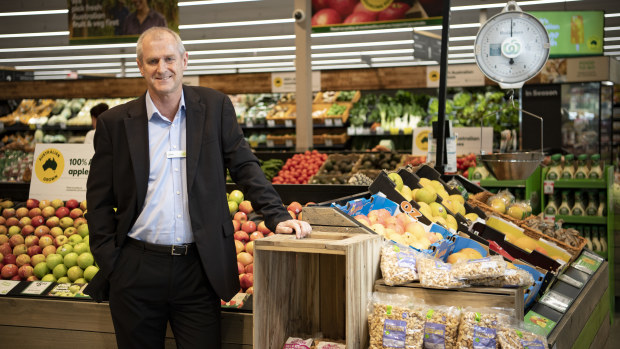Woolworths plans AI driven stores as cloud transformation bears fruit

Woolworths will use the greater data crunching capacity from running multiple applications in the cloud, to adopt artificial intelligence in planning what products should appear in different stores.
The supermarket giant's technology boss has revealed Woolworths is well advanced in plans to migrate its key internal enterprise applications into the cloud.

Woolworths chief information officer John Hunt said the cloud push is moving fast, and more intelligent systems will help individually tailor the contents of store shelves. Wolter Peeters
The company has seen a surge in online sales throughout the COVID-19 pandemic, but was already committed to a wide-ranging digital transformation.
Chief information officer John Hunt told The Australian Financial Review the pandemic had not slowed the pace of his tech plans, and cost savings and efficiencies associated with running technology off externally owned infrastructure would be matched by the increased operational capabilities that can come from apps run in Microsoft's Azure and Google's cloud.
"We've migrated in the region of 50 per cent of our apps onto cloud, and we want to get to 100 per cent to be honest, but there might be one or two, which are not suitable for one reason or another," Mr Hunt said.
"So our plan right now is to get to around about 80 to 90 per cent by this time next year. And the cloud of choice be it our private cloud, be it a public cloud, really depends on the application or what we're trying to do."
While a lot of the benefits of tech work involved in a digital transformation and cloud migration are mainly appreciated inside a company, through cheaper running costs and improved systems, Mr Hunt said customers will notice Woolies stores are increasingly different in different locations.
Woolworths has been working to better tailor the range in each store and region for a number of years now, but is now implementing a localisation engine, which applies AI algorithms to various data sources to help store managers decide on which ranges to introduce, promote or discard.
Despite a perception that all big stores sell the same thing, Woolies has around 35,000 products in its warehouses, but a typical supermarket only stocks around 20,000.
"There's lots of different types of data to process, there's historical data, customer data, data in terms of sales, and then generating a view of what the opportunities are. Because it's not only about what's not selling well, but where there is the opportunity to put something into the stores," Mr Hunt said.
"In the data space we just never previously had the ability as a business to deal with the volume, I always joke that we've always had big data, we just never had big compute. So it's giving us a wonderful opportunity now to actually put all that data to work and drive decisions."
As part of its ongoing tech transformation Woolies has signed on with US-based tech giant Dell Technologies, to use its equipment as part of a new Woolworths Group Hosting Service, which will bring its public and private clouds together.
Known as a hybrid cloud model, it means Woolworths can use the huge capacity of public cloud infrastructure from the likes of Microsoft and Google, while retaining some sensitive systems on equipment that is only used for Woolworths.
Woolworths will use the Dell Technologies Cloud to manage critical services such as its Blue Yonder supply chain system, its transport management applications, as well as the Kronos workforce application, which handles the human resources and payroll management for its 215,000 employees.
One major application transition to the cloud will be Woolworths' extensive use of enterprise resource planning software from German giants SAP. The tech giant is embarking on a company-defining shift from its laborious but profitable systems running on the companies' own systems to a newer cloud-based version called S/4Hana.
The vast reaches of SAP software across different systems across Woolworths, will make it a complex transition and Mr Hunt said the work was being done in stages.
"We have now commenced with our plan to migrate our SAP environment on to (Microsoft) Azure. Initially, SAP systems then when it's on there... we'll start the S/4 journey," Mr Hunt said.
"Meanwhile our data platform has been on GCP (Google Cloud Platform) for about 18 months and we've got about 70 per cent of our data migrated onto that. We decommissioned Teradata three weeks ago, I smiled to myself because I actually pulled the pin out of the building."
While its store staff have remained on the front line throughout the pandemic, Mr Hunt said its corporate and back office staff are still mostly working from home. Woolworths' offices are open, but he said only around 15 to 20 per cent of workers are likely to be in on any given day.
The fact Woolworths was already well advanced in its technology upgrades has meant this new hybrid workforce has been embraced relatively easily, and Mr Hunt said his longer-term planning was based around the assumption staff would never fully return to their pre-COVID routines.
"I think it's changed forever. I do think it will evolve a bit closer to what it was before, but never get back to where we were," he said.
"I think people have recognised that the technology does give the ability to properly work remotely now, with video conferencing and collaboration tools making a big difference. I also think it's made management realise it's actually okay, and that staff can actually be effective and productive working remotely."
Subscribe to gift this article
Gift 5 articles to anyone you choose each month when you subscribe.
Subscribe nowAlready a subscriber?
Introducing your Newsfeed
Follow the topics, people and companies that matter to you.
Find out moreRead More
Latest In Technology
Fetching latest articles